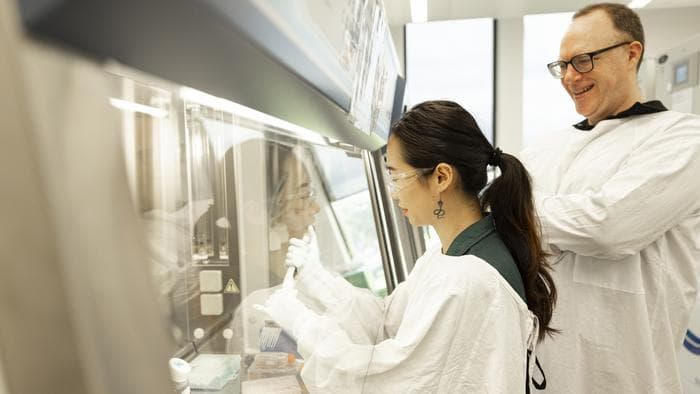Scientists discover new antidote for cobra venom
Scientists have discovered that heparin, a common blood thinner, could be repurposed as an effective treatment for cobra venom-induced necrosis, potentially revolutionising snakebite treatment in low- and middle-income countries.
In a groundbreaking study, researchers from the University of Sydney and Liverpool School of Tropical Medicine have uncovered a novel application for heparin, a widely used anticoagulant. The team’s findings suggest that this readily available medication could serve as an inexpensive and efficient antidote for the tissue-destroying effects of cobra venom, addressing a critical gap in current snakebite treatments.

Professor Greg Neely and lead author Tian Du
The research, published in Science Translational Medicine [1], employed CRISPR gene-editing technology to identify potential targets for blocking cobra venom’s destructive effects. Through this innovative approach, the team discovered that heparin and related drugs could effectively halt the necrosis caused by cobra bites.
Professor Greg Neely from the Charles Perkins Centre and Faculty of Science at the University of Sydney, a corresponding author of the study, explained the significance of their findings: “Our discovery could drastically reduce the terrible injuries from necrosis caused by cobra bites – and it might also slow the venom, which could improve survival rates.”
Cobra bites claim thousands of lives
Snakebites, particularly those from cobras, continue to pose a significant public health threat in many parts of the world. Each year, cobra bites claim thousands of lives and leave countless more victims with severe injuries, including tissue necrosis that can lead to amputation.
Current antivenom treatments, while crucial for survival, often fall short in addressing the localised tissue damage caused by cobra venom. Moreover, these treatments can be prohibitively expensive and difficult to access in many affected regions.
The mechanism of action
The research team’s breakthrough came from their investigation into the human genes targeted by cobra venom to induce necrosis. They found that the venom interacts with enzymes responsible for producing heparan and heparin, molecules naturally present in human and animal cells.
Tian Du, the study’s lead author and a PhD student at the University of Sydney, elaborated on their findings: “Heparin is inexpensive, ubiquitous and a World Health Organization-listed Essential Medicine. After successful human trials, it could be rolled out relatively quickly to become a cheap, safe and effective drug for treating cobra bites.”
A novel approach to antivenom
Unlike traditional antivenoms, which are based on 19th-century technologies, the heparinoid drugs act as a ‘decoy’ antidote. By flooding the bite site with these molecules, the treatment can bind to and neutralise the tissue-damaging toxins within the venom.
Professor Nicholas Casewell, Head of the Centre for Snakebite Research & Interventions at Liverpool School of Tropical Medicine and joint corresponding author of the study, highlighted the potential impact of this discovery: “Our findings are exciting because current antivenoms are largely ineffective against severe local envenoming, which involves painful progressive swelling, blistering and/or tissue necrosis around the bite site. This can lead to loss of limb function, amputation and lifelong disability.”
The World Health Organization has identified snakebite as a priority in its programme for tackling neglected tropical diseases, setting an ambitious goal to halve the global burden of snakebite by 2030. This new research could play a crucial role in achieving this target.
Professor Neely expressed hope for the future application of their findings: “We hope that the new cobra antidote we found can assist in the global fight to reduce death and injury from snakebite in some of the world’s poorest communities.”
The discovery of heparin’s potential as a cobra venom antidote is part of a larger, systematic approach to finding treatments for deadly or painful venoms. Professor Neely’s team at the Dr John and Anne Chong Laboratory for Functional Genomics at the Charles Perkins Centre utilises CRISPR technology to identify genetic targets of venoms and toxins in humans and other mammals. This knowledge is then used to design targeted interventions to protect against the deadly effects of these venoms.
This approach has already yielded promising results, including the identification of an antidote to box jellyfish venom in 2019.
The road ahead
While these findings represent a significant step forward in snakebite treatment, further research and clinical trials will be necessary before heparin can be widely implemented as a cobra venom antidote. However, the potential for a readily available, affordable, and effective treatment offers hope for millions of people living in cobra-inhabited regions.
As the global health community continues to work towards reducing the burden of snakebite envenoming, this research serves as a testament to the power of innovative scientific approaches in addressing long-standing medical challenges.
Reference:
- Du, T., et al. (2024). Molecular dissection of cobra venom highlights heparinoids as an effective snakebite antidote. Science Translational Medicine.
https://doi.org/10.1126/scitranslmed.adk4802

